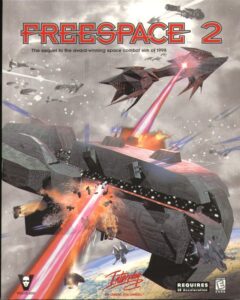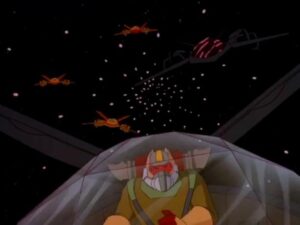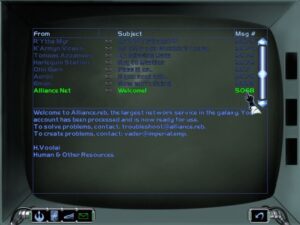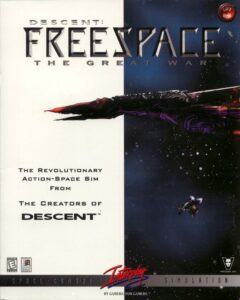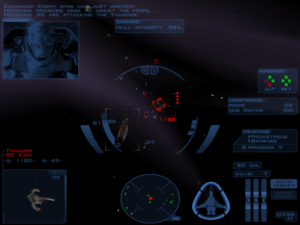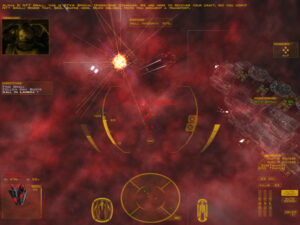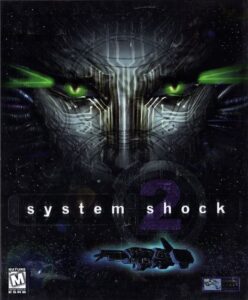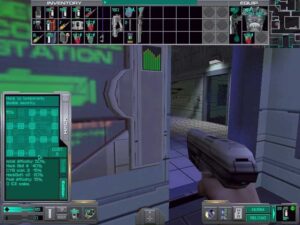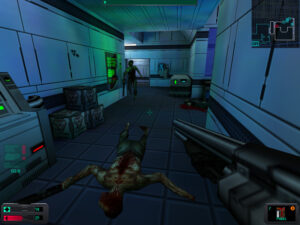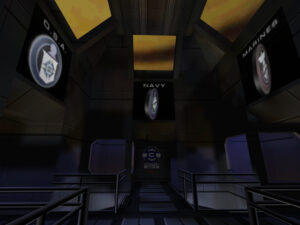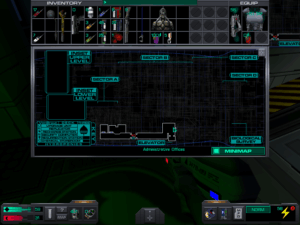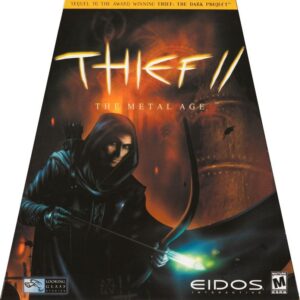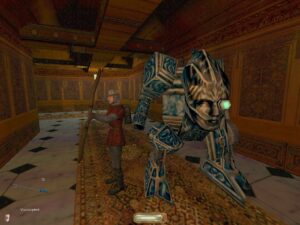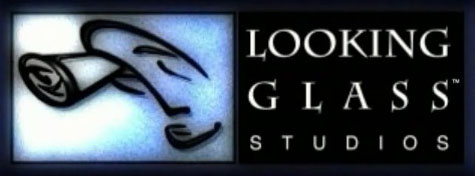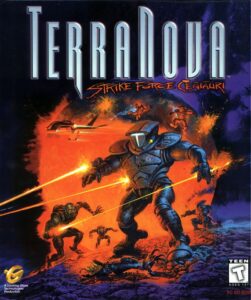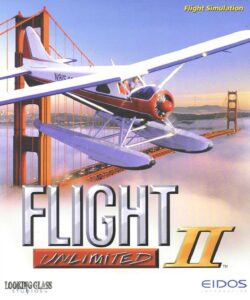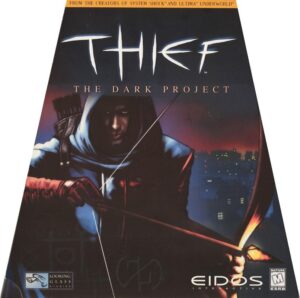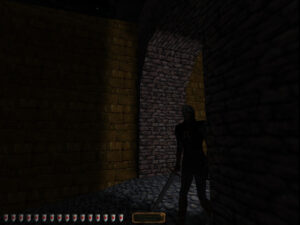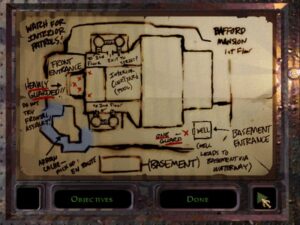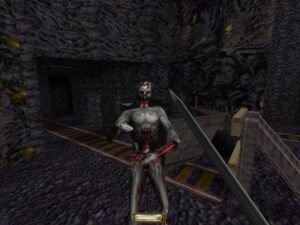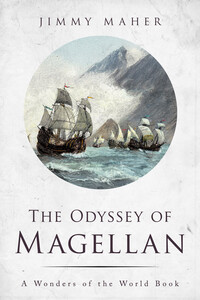What I’d really like to do is a game where you could travel from planet to planet — and there would be hundreds of planets — with full 3D action. You could go down and explore each planet in detail and interact with all sorts of live-action characters. Plus you could retool your ship with lots of different guns and engines.
The project would feature all the best elements of adventure and virtual reality, but with the same high production level of a Hollywood blockbuster. That means big-name stars and the look and quality of, say, Bladerunner. I guess my goal is to bring the superior production values of large Hollywood movies into the interactive realm — creating an environment that is really cool and fun and where you can spend hundreds of hours exploring a virtual universe that seems totally lifelike down to the smallest detail. Sort of a SimUniverse on steroids!
— Chris Roberts in early 1995, speaking from the department of The More Things Change…
One thing I believe I have learned during my 50-plus years on this planet is that flawed people are far more commonplace than genuinely, consciously bad ones. Given this, I try not to rush to attribute to malice aforethought that which can be explained by simple human weakness. I try to apply this rule when I weigh the surprising number of game developers who were well-nigh universally admired giants in their field during the twentieth century, only to become magnets for controversy in the 21st.
Thus I prefer to believe that Richard Garriott’s habit of lending his name to sketchy endeavors that never live up to expectations stems not from conscious grift but from a desire to still be seen as a gaming visionary, which is unfortunately accompanied by a reluctance to do the hard work that making really good games entails. Likewise, I think that Peter Molyneux’s habit of wildly over-promising stems not from his being “a pathological liar,” as journalist John Walker once infamously called him, but rather from a borderline pathological tendency to get high on his own supply. I’m prepared to come up with excuses for John Romero, for George Broussard, even for those two guys who have been trying to make a Space Quest successor — a dubiously necessary proposition in itself — for about fifteen years now. When you combine real but fairly venial character flaws with the eternal tendency of some fans to take their hobby just a little bit more seriously than it probably deserves, the result can be a toxic stew indeed.
Yet I must confess that one old warhorse from gaming’s younger days does give a degree of pause to my rationalizing. Few people have ever stretched so thin a thread of actual creative talent so far as has Chris Roberts. In the process, he’s amply demonstrated that his larger talents are for failing upward, and getting people to give him flabbergasting amounts of money while he’s at it. I’m not yet prepared to call him a conscious grifter, mind you, but I do think that there is a lot more plotting going on behind that seemingly guileless chipmunk smile of his than we might first suspect. Never fear: I’m not going to jump the chronology entirely to wade into the argument over whether Star Citizen, the most expensive game ever made even though it has not yet been made, was a giant scam from the start, a good-faith effort that later became a scam, or is still an honest endeavor thirteen years after its initial Kickstarter. What I do want to do is examine the period in Chris Roberts’s life between Wing Commander IV in 1996 and that first splashy Star Citizen Kickstarter of 2012. Who knows? Maybe doing so will help to explain some of what came later.
I have infinite respect for Chris Roberts, who wants to make interactive movies, but I can get a better cinematic experience by watching reruns of Diff’rent Strokes than by playing Wing Commander IV.
— Warren Spector, March 1997
In the summer of 1996, after it had become clear that Wing Commander IV was going to struggle just to earn back its development budget of more than $10 million, the management of its publisher Origin Systems sat down with Chris Roberts, the Wing Commander series’s creator and mastermind, to discuss the future of what had been the most popular franchise in computer gaming just a few years earlier. With a heritage like that behind it, the inhabitants of Origin’s executive suites weren’t yet ready to give up on Wing Commander completely. Yet they made it clear to Roberts that the next installment would have to scale back the budget and place less emphasis on the interactive-movie side of the experience and more on the space-combat side, in order to address a mounting chorus of complaints that the latter had been allowed to grow stale and rote in the last couple of installments while Roberts poured all of his energy into the former. Roberts thought for a few days about whether he was willing to continue to make Wing Commander games under his managers’ new terms, then turned in his resignation. No one could possibly have imagined at the time that Chris Roberts, who was not yet 30 years old, would still be one of the most prominent game developers in the world 30 years later, even though he would never manage to complete and ship another game of his own during that span of time. Our world is a deeply strange place sometimes.
That October, Roberts filed the necessary paperwork to found a company of his own with two other former Origin people: his brother Erin Roberts, who had just produced the poorly received Wing Commander spinoff Privateer 2: The Darkening, and Tony Zurovec, the programmer and designer behind the reasonably successful action-adventures Crusader: No Remorse and Crusader: No Regret. They called their new studio Digital Anvil. “I liked the idea of a name that could suggest Old World care and craftsmanship in the digital age,” said Roberts. “It’s like we’re hammering out fantastic experiences in our little forge.” By his account, their method of seeking funding was breathtaking in its naïveté. They got their hands on Bill Gates’s email address, and simply wrote him a letter. Incredibly, they received a call the next day from Ed Fries, who had been tasked with making Microsoft a major player in games, one of the few software markets the foremost ruthless mega-corporation of the era had yet to conquer. He had been given serious money to spend to make that initiative a reality. Digital Anvil, in other words, had been lucky enough to strike while the iron was hot.
On February 19, 1997, a press release announced that Microsoft had signed Digital Anvil to “a multi-title publishing deal” which entailed “a significant investment” on its part — in fact, an investment that made Microsoft the owner of just short of half of the new company. The trio of founders set up shop in rather lavish fashion in downtown Austin, Texas, not far from Origin’s offices. They hired an initial staff of about 35 people, who got to enjoy such Microsoft-funded perks as an onsite state-of-the-art movie theater with Dolby Sound and leather seats. On paper at least, the staff of Digital Anvil made for a diverse and impressive group. Hidden amidst a galaxy of bright and eager faces out of the nearby University of Texas could be glimpsed Chief Technology Officer John Miles, whose Miles Sound System had long been the standard for audio programming among game developers, and Robert Rodriguez, a young filmmaker who had recently directed Quentin Tarantino’s script of From Dusk Till Dawn and was now being talked about as the burgeoning Austin film scene’s next Richard Linklater. “The parameters of the film world are pretty set,” said Rodriguez. “You’ve got to work with a two-hour chunk of time and things like that. Some of the stories I want to tell don’t fit within those slots.”
Rodriguez’s presence was arguably the first sign of the muddled priorities that would become a fact of life at Digital Anvil. Chris Roberts told the magazine Texas Monthly in the summer of 1997 that the studio had four games in the works: a real-time-strategy game called Conquest, a Mad Max-inspired driving game called Highway Knight, a hyper-ambitious multiplayer space sim called Freelancer, and Rodriguez’s amorphous project, which was called Tribe. (“The idea is, he will write a movie, possibly direct it, and then write a game.”) Another game in the pipeline that went unmentioned was Erin Roberts’s Starlancer, which was to be a linear space sim with a set-piece story line, an even more obvious successor to Wing Commander than was Freelancer. (Students of the Robertses’ later careers will recognize a kinship between Freelancer and Starlancer on the one hand and Star Citizen and its single-player companion Squadron 42 on the other.) That’s five games in all: it was quite the agenda for such a small studio. And then the movies came calling.
If Robert Rodriguez was a filmmaker who was tempted by the possibilities of games, Chris Roberts was the opposite, a game maker who seemed for all the world like he really wanted to be making movies; if Wing Commander III and IV had shone a spotlight on nothing else, it was this. While still working for Origin Systems, he’d come up with an outline for a non-interactive Wing Commander movie. He gave it to Kevin Droney, a screenwriter who had earlier turned the Mortal Kombat games into a movie, to make a proper script out of it, then sent it to Hollywood on a wing and a prayer: “It was my passion project, my baby.” It finally reached a hard-bitten Svengali of a producer named Todd Moyer. He pronounced it “pretty bad” — “basically, it was a C-rate Star Wars ripoff” — but his ears perked up when the agent who had sent it to him explained that Wing Commander was a hit series of computer games. “I’m not very reverential toward videogame creators,” Moyer confesses. “Games just don’t get me excited.” Or rather, they didn’t do so as creative productions in their own right; as product lines, Moyer saw them as a largely untapped opportunity for franchising: “Once you own [the] intellectual property, you can carve out very different deals for the creators and for a lot of people.” Chris Roberts fell under Moyer’s spell from the first meeting, which came right in the middle of all of the work to build out Digital Anvil. For he had no fonder dream than that of making a real Hollywood movie, and he definitely wasn’t going to let the games studio he was building at the same time get in its way. Moyer was telling him precisely what he most wanted to hear.
That said, it’s fair to ask who was really pulling the wool over whose eyes. Whereas the movie industry revealed as a matter of course and trade-union law how much each film had cost to make and how much it earned back in ticket sales, budgets and sales figures were regarded as trade secrets by game publishers, to be divulged only when doing so served their interests. It’s hard not to suspect that Chris Roberts benefited from this opacity, which required an insider’s perspective to begin to penetrate. Todd Moyer was no one’s idea of a babe in the wood; nor for that matter was Microsoft’s Ed Fries. Yet both were new to the games industry, and by all indications in a bigger hurry to sign deals than to do their due diligence. The culture of gaming moved fast in the 1990s. Describing Wing Commander as a “series of hit computer games” in 1997 wasn’t an outright lie, but it did neglect the salient fact that this series’s best days as a marketplace proposition were already well behind it, that the last couple of Wing Commander games hadn’t been hits at all. While the series certainly still had its fans, far more hardcore gamers in 1997 were excited about Quake and Warcraft II and Diablo than Wing Commander. In short, there was ample reason for the observant to question how much appetite there really was for a Wing Commander movie — or, now that we’re on the subject, for the new space sims that Digital Anvil proposed to craft in the image of Chris Roberts’s most famous creation.
Nevertheless, Todd Moyer took it upon himself to make the movie happen, just as Microsoft had agreed to fund the games. He sent Droney’s screenplay to some (uncredited) script doctors for some hasty revision. He judged the new version “only a little bit better” when it came back to him, but decided it was good enough for franchise work. He convinced a rather bemused-seeming Origin Systems to agree to license the Wing Commander name and characters in return for a small piece of any profits. He convinced 20th Century Fox — the house that built Star Wars, as Chris Roberts knew well — to agree to distribute the eventual film to theaters. He didn’t even blink when Roberts came to him with his one real demand: that he be allowed to direct the movie himself. “No one gave a shit about Chris Roberts as a director or not a director,” he says. “With these movies, at the right price, nobody cares who directs them.”
In the end, Moyer put together what journalist Jamie Russell describes as “a stunning deal — or rather series of deals — that jigsawed together money from all over. It began with a small domestic minimum guarantee from Fox and was followed by a Luxembourg tax incentive, some French investment, an Australian tax shelter, UK financing, and foreign sales.” The whole pot together came to almost $30 million — a relatively modest sum by Hollywood action-movie standards, but three times what Chris Roberts had had to hand when he shot the movie parts of Wing Commander IV.
Roberts and Moyer would have few kinds words to say about one another in later years. “While Todd was good at doing deals, he didn’t give a damn or even know much about the creative process,” said Roberts in 2012. “As a first-time director, I really could have used the support of a proper creative producer who understood film-making and being on the set, rather than an ex-agent who couldn’t tell you the difference between a single or a master shot.” And yet for all the rancor that would follow the Wing Commander film becoming a laughingstock, it seems pretty clear from his subsequent career that Roberts was watching with keen eyes as Moyer scraped together funding for the movie in all sorts of head-scratching ways.
Indeed, even at this early juncture, Roberts was savvy enough to put together one eyebrow-raising arrangement of his own: he “hired” Digital Anvil, his own company, to provide the movie’s visual effects, thus funneling some substantial portion of that $30 million budget into his and his colleagues’ own coffers long before the movie ever made it into theaters. With this windfall, Digital Anvil doubled in size and announced to the world that they were now a cinematic special-effects house as well as a games studio. Chris Roberts insisted publicly that the two halves of the company were “entirely unrelated, except for me,” but nobody believed him. Coincidentally or not, John Miles and Robert Rodriguez both left Digital Anvil soon after. (Rodriguez would go on to become the marquee Hollywood director that Roberts had always dreamed of becoming, turning out hits such as Spy Kids and Sin City.) Microsoft, which had made its “significant investment” in Digital Anvil in the expectation that the studio would exclusively make games exclusively for it, could hardly have been pleased by the pivot into conventional film-making, but it showed remarkable patience and forbearance on the whole. Knowing that his mega-corp’s reputation as a ruthless monopolist preceded it, Ed Fries was determined to present a different face to the games industry, to show that Microsoft could be a good, supportive partner to the studios it took under its wing. An ugly lawsuit against Digital Anvil — even a justified one — would not have forwarded that agenda. Once again, in other words, Chris Roberts got lucky.
The cast of the Wing Commander movie was brokered by Todd Moyer, in ways intended to protect the piebald interests of his many investors. In one of their first conversations, he had carefully explained to Chris Roberts that Mark Hamill, the star of the third and fourth Wing Commander games, was not adored by the general public for having once played Luke Skywalker in the same way that he was by the hardcore-gaming demographics. To John and Jane Doe, he was just a middle-aged curiosity for the “Where are they now?” file. The rewritten script offered up as the protagonist a fresh-faced space jockey who had just earned his wings, a perfect fit for a younger, up-and-coming actor. It turned out that Fox had just such an actor in mind: Freddie Prinze, Jr., a 21-year-old who had recently become regular cover fodder for the teen magazines, thanks to a star turn in I Know What You Did Last Summer, a slasher flick that earned $125 million at the box office in 1997. He would play an earlier incarnation of Christopher Blair, Mark Hamill’s old role. For his sidekick Todd “Maniac” Marshall, Fox proposed another product of the 1990s teen-horror craze: Matthew Lillard, who had played a serial killer in Scream. Other cast members were hand-picked to enhance the film’s appeal in foreign markets: David Suchet, known to a generation of British television viewers for his depiction of Agatha Christie’s fussy detective Hercule Poirot; Jürgen Prochnow, who had portrayed a U-Boat captain in the German classic Das Boot; Tchéky Karyo, a veteran French character actor whose CV included films like The Bear and La Femme Nikita. Betwixt and between all of the new faces, there was some talk of bringing back some of the supporting cast from Wing Commander III and IV — the most sustained discussions were held with Malcolm McDowell — but all of those negotiations ultimately fell through for one reason or another. When all was said and done, the cast for the movie overlapped not at all with the one from the games.
As a byproduct of the Luxembourg tax incentives that had helped to bring it into being, the entirety of the movie was shot on a sound stage there between February and April of 1998. The process was by most accounts a difficult one at times. Not only had Chris Roberts never received any formal training as a film director, but the cast and crew had three different mother tongues, with wildly varying levels of proficiency in the other two languages. Still, by no means was it a case of rank amateurs at every level. The set designer, for example, was Peter Lamont, who came in fresh off James Cameron’s Titanic, the biggest blockbuster in film history; the cinematographer was Thierry Arbogast, who had just performed that same task for the The Fifth Element.
Once the shoot was finished, Chris Roberts returned to Austin with his reels of raw footage, to begin the work of splicing it together with the outer-space scenes being generated at Digital Anvil and turning it all into a proper movie. By December of 1998, he had a rough cut ready to go. In keeping with time-tested Hollywood tradition, Fox arranged for a handful of preview showings to ordinary members of the public. The feedback that came in was enough to tell the Fox executives, even if their own critical faculties could not, that they had a potential boat anchor — or maybe an anvil? — on their hands. They were left pondering what to do with this less-than-stellar take on outer-space adventure.
After hearing that Fox was considering condemning the movie to the memory hole of a direct-to-videotape release, Todd Moyer tried to buy the film studio out so that he could shop Wing Commander elsewhere. But at the end of January of 1999, just when he thought the buy-out deal was done, he got a phone call from Tom Sherack, Fox’s head of distribution. As Moyer reported it to Jamie Russell decades later, their conversation went something like this:
“Todd, I’m not giving you the picture.”
“But we had a deal!”
“Good fucking luck. I’ll never sign the papers. I don’t give a shit. I’m not doing it. If you want to have a huge lawsuit, go ahead.”
“Tom, I’ve got to tell you…
“No! It’s coming out in six weeks, and it’s going to have the Phantom Menace trailer on it.”
The Phantom Menace, George Lucas’s feverishly anticipated first prequel to his classic Star Wars trilogy, was scheduled to hit theaters in May of 1999. At the last minute, Fox had had the clever idea of attaching a trailer for that movie to the start of Wing Commander, making the latter the first place where the Star Wars faithful could catch a glimpse of what awaited them later that spring. Wing Commander was promptly slated for release in March of 1999, giving George Lucas and company just enough time to put the trailer together. It left no time, on the other hand, to mount a proper advertising campaign for Wing Commander. Nor did it leave Chris Roberts and company much time to try to fix the many infelicities that had been pointed out by the preview audiences.
The official Wing Commander world premiere took place on March 12. It was less than a gala affair, being held in Austin rather than Hollywood, with none of the cast in attendance; the actors in question were still saying polite things about the movie when forced into it, but quite obviously preferred to talk about something else. (Freddie Prinze, Jr., would grow less polite in later years, calling Wing Commander “a piece of shit” that he couldn’t stand to see or even think back on.) It appeared on 1500 screens across the country that same weekend, complete with the Star Wars trailer that Fox hoped would prove its secret weapon.
Alas, even this potent last-minute triage wasn’t enough to save the patient. Wing Commander brought in $5 million the first weekend, good for seventh place in the box-office listings. The reviews that appeared at the start of the following week were savage. Every critic in the land piled on to see who could come up with the best zinger. (Cinemax: “Filmed in Luxembourg(!), this low-flying turkey is an international co-production between the U.S., France, England, Germany, and Ireland. That pretty much spreads the blame as Wing Commander, in any language, goes down in computer-generated flames.” Entertainment Weekly: “It’s enough to make you wonder if the geniuses at Fox deliberately decided to release a movie this lifeless. They may have figured that everyone who showed up to see the new Star Wars trailer would be so bored by the main feature that they’d exit the theater screaming for a science-fiction movie that was actually fun.” SF Gate: “Wing Commander is the latest exhibit in the case to prove that Star Wars has wrecked American cinema.”) Perhaps in response to the reviews, more likely just as a result of natural gravity — most of the hardcore fans of the computer games presumably went out to see it right away — the movie earned just $2.2 million the next weekend, dropping to eleventh place. The third weekend, it was in fifteenth place with earnings of $1.1 million, and then it was out of American theaters and off the charts forever. A planned panoply of Wing Commander action figures, toy spaceships, backpacks, lunchboxes, tee-shirts, and Halloween costumes either never reached stores at all or were pulled from the shelves in short order. Star Wars this movie was not, in all sorts of ways.

Origin flew the teenage proprietors of the biggest Wing Commander fan site down to Austin for the premiere. (Aren’t they adorable, by the way?) They saw the movie four times in a single weekend — not a fate I would wish on anyone, but more power to them.
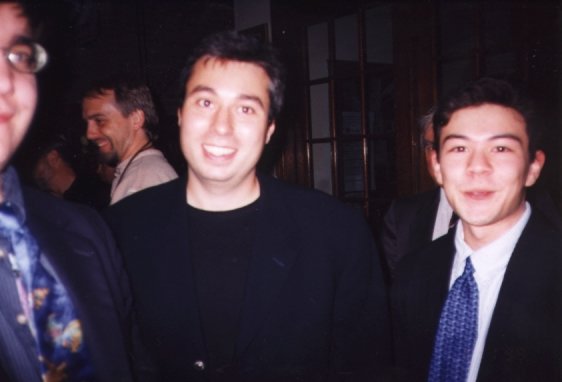
Chris Roberts at the premiere. Another fan in attendance wrote that “he seemed to be stressing that if he had had more money and time to spend on the movie, he would have made some changes.”
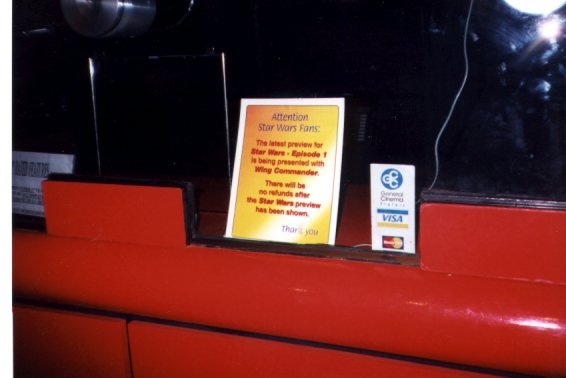
The general public was somewhat less enthused than our friends who saw the movie four times. These signs started to appear in theaters after it became a trend for patrons to buy a ticket, go in to watch the Star Wars trailer, then walk out and ask for their money back.
In light of the critical drubbing to which it was subjected and its modern-day status as a cinematic punchline, I watched Wing Commander: The Movie for the first time recently with, shall we say, considerable trepidation. My first reaction might serve as an argument for the value of low expectations: in many ways, it actually wasn’t as bad as I expected it to be.
The opening credits were snazzy and stylish, worthy of a far more respectable film. Even once the movie proper began, the production values and acting weren’t anywhere near as terrible as I had anticipated. This is not inexplicable: the belief shared by many fans that Wing Commander was an ultra-low-budget movie doesn’t hold water. As points of comparison, take the three vastly better received films which created and for a time cemented Freddie Prinze, Jr.’s standing as a teen heartthrob. I Know What You Did Last Summer, I Still Know What You Did Last Summer, and She’s All That all sported budgets well below that of Wing Commander; the last named, which was shot after Wing Commander but released before, had only one-third the budget of Chris Roberts’s film. Of course, none of these others were science-fiction films with a need for lots of fancy visual effects. Nonetheless, you don’t sign a heavyweight production designer like Peter Lamont, nor for that matter a potential star-in-the-making like Prinze, if you don’t have a certain level of connections and financial resources.
All of which is to say that, if you were to walk into a room where Wing Commander happened to be showing on the television, it wouldn’t jump out to you immediately as B-grade schlock in the way of, say, the notorious Plan 9 from Outer Space. The sets look good enough; the cinematography and sound design are perfectly professional; the acting doesn’t stand out for being awful either. In an ironic sort of way, all of this is a problem, for it means that Wing Commander manages to be just good enough to be merely boring and irritating rather than lovable in its sheer cluelessness.
My second big takeaway from watching the Wing Commander movie is closely related to my first: I was surprised at how similar it is to the computer games, after having heard legions of fans complain about just the opposite. There’s the same jarring bifurcation between the scenes of character interaction, which are shot like a conventional movie, and the ones depicting the action in outer space, which are completely computer-generated and, indeed, look very much like scenes from a game — a game, that is, made five to ten years after this movie was made. Likewise, there’s the same sense of a cast and crew of professionals doing their level best, knowing that what they’re creating is never going to be high art or even high entertainment, but feeling a craftsman’s responsibility to make the material come across as well as it possibly can. Nobody in film ever wants to be the weak link, even on a bad movie.
Rather than being awful on the face of it, then, Wing Commander is awful in a subtler way. Its problems all stem from the script, which doesn’t do the things that even popcorn-movie storytelling needs to do to be successful, and from its director’s baffling decisions about what parts of the script to leave in and leave out. A work of fiction — any work of fiction — is a clockwork mechanism beneath the surface. The author has to move her characters around in arbitrary ways to set up the plot beats her narrative requires. The art comes in making the mechanistic feel natural, even inevitable; at the risk of hopelessly muddling my metaphors, call it applying the flesh and sinew that are needed to conceal the bones of the story. In Wing Commander, said bones are poking out everywhere. The result feels so artificial that one is left looking for a stronger word than “contrived” to try to capture it.
Take the opening beats. The race of evil felines known as the Kilrathi attack a Terran Confederation flagship and secure — just to provide a note of contemporary relevance for those of us living in the third decade of the 21st century — an “AI” that can lead them to Earth, the location of which planet is for some reason unknown to them. This is an existential threat for the Terrans.
There’s just one ship that might be able to intercept the Kilrathi and report on their numbers and disposition before they make the jump to Earth: the outer-space aircraft carrier Tiger’s Claw. Unfortunately, it’s impossible for Terran High Command to tell this ship to do so because it is “beyond the reach of our communications.” (Presumably, the Tiger’s Claw’s radio will start working again before it’s time to send the report on the Kilrathi.) Luckily, a resupply vessel which can be reached is on its way out to the Tiger’s Claw. Even better, this resupply vessel is captained by one “Paladin,” some sort of special Terran “scout” who is only playing the role of the captain of an ordinary freighter. (What he or anyone else hopes to achieve by this deception is never explained.) Admiral Tolwyn, who stands at the head of the Terran High Command brain trust, such as it is, likes Paladin so much that he gave him his ring. (Isn’t that sweet?) Now, he needs only call up his favorite scout and tell him to tell the captain of the Tiger’s Claw to get a move on and intercept the Kilrathi.
Is this what he in fact does? No, reader, it is not. Instead Tolwyn remembers that the freighter happens to be ferrying a couple of young pilots fresh out of flight school over to the Tiger’s Claw. One of them is named Christopher Blair. Another Blair with whom he once served — now sadly deceased — was the kid’s father. “He was a good man,” Tolwyn says. On the basis of a zealous belief in eugenics, he elects not to convey the vital orders and intelligence to the grizzled special agent to whom he gave his ring but rather to the wet-behind-the-ears kid whom he’s never met.
It just goes on and on and on like this, with characters constantly making decisions that don’t make any sense. If you want your audience to become invested in your story, you have to provide them with a coherent internal logic that they can follow, no matter how outlandish your larger premise may be.
Another barrier to investment, likewise reflecting a bizarre lack of understanding of the fundamentals of this sort of fiction, is the yawning absence of a villain. Star Wars had Darth Vader; the best-ever Star Trek movie had Khan. Wing Commander has a few animatronic cats who spend less than five minutes onscreen and look absolutely appalling — and not in a good way — while they’re doing it; the Kilrathi are the one place where Wing Commander really does look like a B-movie through and through. To his credit, Chris Roberts was perceptive enough to see that it wouldn’t be a good idea to use the version of the Kilrathi from the games, actors in furry costumes who wound up looking more like cuddly department-store mascots or sports-team cheerleaders than a galaxy-enslaving force for evil. But what he was able to put in their place was not any better, as he also recognized. This explains why they got so little screen time: “The Kilrathi sucked and were basically cut out of the movie.”
A subtler, more aesthetically sensitive director might have spun our lack of eyes on the Kilrathi into a positive, turning their very mysteriousness into a sinister virtue in much the same way that the FreeSpace space sims did their evil aliens, the Shivans. Suffice to say that Chris Roberts was not such a director. The lack of an identifiable antagonist just emphasizes the sense of plot gears arbitrarily clanking around, oblivious to the requirements of compelling fiction. We see a lot of people fighting and dying, but we never know why or against whom or what. A popcorn movie without a villain just doesn’t work.
As for the heroes: this cast could have easily served the purpose if given a stronger script to work with. None of the young actors comes across as unlikable, but no actor could fully compensate for dialog as bad as this. “It takes balls — big balls, not ovaries — to keep track of four enemy fighters!” says Maniac, as the script desperately tries to interest us in a bantering will-they-or-won’t-they situation between him and one of the female pilots. Wing Commander is that guy at a party who thinks he’s hilarious and cool, whom everyone else just thinks is an annoying dweeb.
The image that springs to my mind now when I think back on Wing Commander: The Movie is one that nobody ever talks about. Early in the film, when he and Maniac are still aboard the tramp freighter, Blair has to plot a daredevil hyperspace jump because… Reasons. He does so, using what looks like a Casio calculator keyboard and some innate genetic talent that comes courtesy of his background as a “Pilgrim,” a whole other unnecessary and confusing thing in the script that I can’t be bothered to go into here. Anyway, he plots the jump, and just as it’s about to be made Maniac raises his hands above his head as if he’s riding a roller coaster. As he does so, you can see the most delicious expression on actor Matthew Lillard’s face: he looks all sorts of confused and bemused, as if wondering if this lame joke is really what he’s being asked to do here, even as he’s gamely trying to stay in character and look cocksure and pumped. He gets through the scene, the joke utterly fails to land… and Chris Roberts proceeds to put it in the final cut of his movie, no doubt sure that his audience will find it hilarious. It’s what the kids today call Cringe.
In a saner world, I would be able to end this article by telling you that all of the foregoing explains why Chris Roberts never got another sniff at a career in Hollywood. But he did, my friends… he did. Failing upwards is his superpower.

Our principal cast of hot young pilots. From left to right, Saffron Burrows plays Lieutenant Commander “Angel” Deveraux; Ginny Holder Lieutenant Rosie “Sassy” Forbes; Mathew Lillard is Todd “Maniac” Marshall; Freddie Prinze, Jr., is Lieutenant Christopher “Maverick” Blair. (Is a case of Top Gun envy involved?) Of the four, Lillard makes the best of the bad situation and delivers the most energetic performance. Prinze mostly just stands around looking conflicted and earnest. “I tried to make him young and confused,” Prinze said when asked what he wanted to bring to the character. Exactly what every action-movie lead should aspire to be, right?

Devearux enforces discipline in her squadron by pulling out a gun and threatening to murder one of her pilots. None of her superiors aboard the Tiger’s Claw expresses any concern about this unhinged behavior. For all his obvious fascination with military culture, I’m not sure that Chris Roberts understands how it works.

Maniac and Sassy consummate their romantic relationship with a lot of clumsy thrashing about without ever actually taking off their clothes. Thank God for small mercies. I shudder to think what a real Chris Roberts-directed sex scene would be like.

Oddly, it’s the veteran David Suchet who delivers the worst performance of the cast, constantly swinging between equanimity and rage for no apparent reason. I’m not sure I’d put Hercule Poirot in charge of a starship anyway.

At one point, our World War II aircraft carrier in space suddenly turns into a submarine, complete with sonar pings and “Silence in the boat!” (never mind the soundless vacuum of space) and all the rest. Why? Because Chris Roberts thinks submarines are pretty cool too, that’s why. At least actor Jürgen Prochnow (left) had experience with this sort of thing…

Our space fighters, on the other hand, are decommissioned 1950s-era fighter jets when they’re at home in the hangar.

For the most part, the visual effects that were created by Digital Anvil while they were supposed to be making games for Microsoft aren’t terrible.

The special effects get themselves into serious trouble only when they’re blended with shots of the actors. Not coincidentally, videogames tended to have the same problem.

…or plastic, as in the movie? This is what is known as a Hobbes’s Choice. (There’s a dad joke in there for you old-school Wing Commander fans.)
There has to be someone else out there besides us. I hope they won’t be hostile, and I hope Earth is cool and doesn’t screw up first contact. No doubt our military will be there to greet them, defending the country. That’s not good. These aliens will come out, and they’re not going to be heavily armed because they’re not about that. We have to be mellow and peaceful. If that happens, it’ll be cool. But I don’t think it’ll happen that way. I think we’ll come hard, which is probably standard operating procedure. And that’s not a cool thing because we’ll probably get worked.
— Words of wisdom from Freddie Prinze, Jr., on the possibility of real extraterrestrial contact
Did you enjoy this article? If so, please think about pitching in to help me make many more like it. You can pledge any amount you like.
Sources: The book Generation Xbox: How Video Games Invaded Hollywood by Jamie Russell. Next Generation of March 1997; Computer Gaming World of May 1995 and June 1998; Starlog of May 1999, Austin Business Journal of March 2 1997, Texas Monthly of September 1997.
Online sources include “Chris Roberts explains what went wrong on the Wing Commander film” by Ben Kuchera at Penny Arcade, a 1998 Games On Line interview with Chris Roberts, a 2012 Chris Roberts “Ask Me Anything” from Reddit, a Microsoft press release announcing the Digital Anvil investment, the 1999-vintage Dan’s Wing Commander: The Movie Page (including the proprietor’s story of attending the premiere), and a 2002 Wing Commander retrospective by the German website PC Player Forever. I made extensive use of the Wing Commander Combat Information Center, and especially its voluminous news archives that stretch all the way back to 1998.
My invaluable cheat sheet for this article was “The Chris Roberts Theory of Everything” by Nick Monroe from Gameranx.






